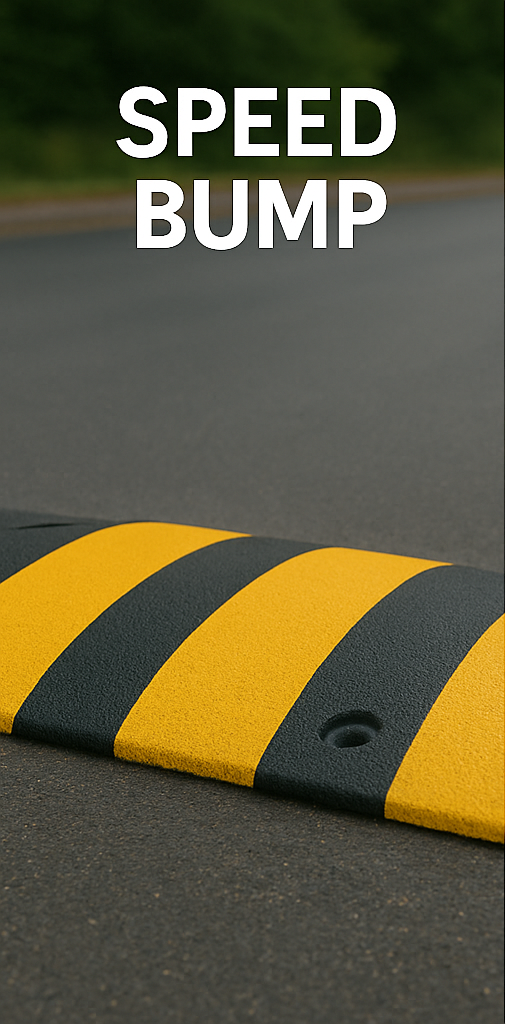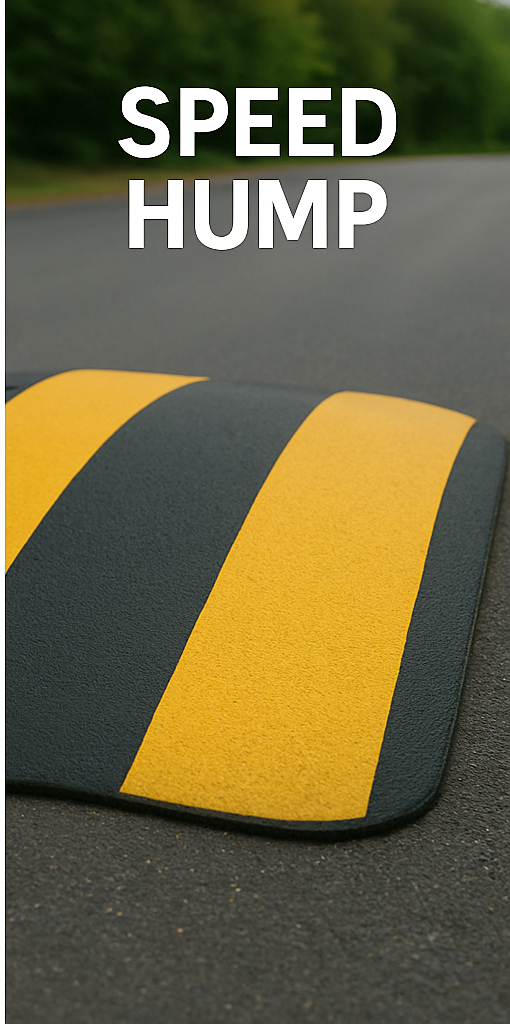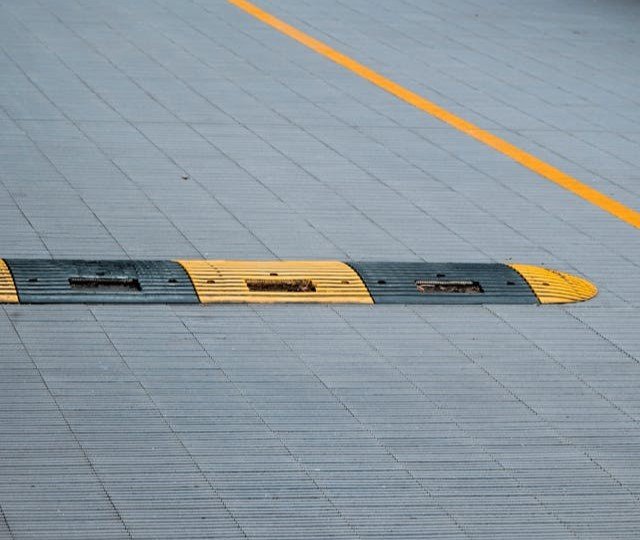For property managers responsible for commercial, industrial, or mixed-use sites, traffic control is a key safety and liability concern. One of the most common questions that arises when implementing traffic calming measures is whether to install speed bumps or speed humps. While they might seem similar at first glance, the differences between the two can significantly impact traffic flow, vehicle safety, pedestrian protection, and overall site operations.
Choosing the wrong option can lead to complaints, increased maintenance, or even liability. This guide breaks down the differences and helps property managers make the right decision based on specific site needs and conditions.
What Are Speed Bumps?
Speed bumps are short, abrupt traffic calming devices typically 2 to 4 inches high and only 1 to 2 feet long. Their primary purpose is to force drivers to significantly reduce speed when passing over them.
They are commonly made of rubber, plastic, or asphalt and are often found in private roads, parking lots, loading zones, and low-speed internal driveways.
Key Features of Speed Bumps:
- Force speeds down to 2–5 mph
- Cause a jolt if taken too fast
- Best suited for very low-speed environments
- Often used in private properties rather than public roads

What Are Speed Humps?
Speed humps are wider and more gradual traffic calming devices, generally between 10 and 14 feet long and around 3 to 4 inches high. They are designed to reduce vehicle speed more gently, allowing vehicles to pass over them at 10 to 20 mph without sharp jolts.
They are typically installed on public roads, apartment complexes, business parks, and shared driveways where moderate speed control is necessary without harsh deceleration.
Key Features of Speed Humps:
- Reduce speeds to 10–20 mph
- Provide a smoother transition over the hump
- Suitable for roads with regular traffic
- Help control speed without disrupting flow

Main Differences Property Managers Must Understand
Understanding how bumps and humps behave in real-world conditions helps in making better installation decisions. Here’s a comparison of the two across critical factors.
1. Purpose and Application
Speed bumps are meant to virtually stop vehicles or make them crawl. They are effective where extreme caution is needed, such as near building entrances, crosswalks, loading docks, or pedestrian-heavy parking lots.
Speed humps are designed for areas where moderate speeds are acceptable, but control is still needed. They are used in longer driveways, internal roads, and streets within gated communities or business campuses.
2. Vehicle Type Consideration
If your property deals with heavy trucks, forklifts, or emergency vehicles, abrupt speed changes from speed bumps can be problematic. They may cause discomfort, slow emergency response, or damage to vehicles with low clearance.
Speed humps allow smoother passage for larger vehicles, which makes them more appropriate for shared-use roadways. Speed bumps are better where passenger vehicle control is the priority and heavy vehicles are minimal.
3. Safety and Pedestrian Protection
Speed bumps are excellent in pedestrian-heavy zones where the highest level of caution is required. By forcing vehicles to nearly stop, they significantly reduce the risk of pedestrian accidents.
Speed humps, while less aggressive, still help maintain safe driving conditions in moderately busy areas. They work well near playgrounds, office complexes, or facility driveways where people frequently walk but where traffic must continue moving.
4. Impact on Traffic Flow
Speed bumps slow down traffic dramatically and may cause vehicle backups if not placed strategically. Overuse can lead to frustration, driver aggression, or even avoidance of the area.
Speed humps provide a balance between safety and flow. They reduce speeds without causing long delays or operational interruptions, making them ideal for main internal roads or large parking facilities.
5. Installation and Cost
Speed bumps are typically easier and cheaper to install. Many rubber or plastic versions can be bolted directly onto the surface and removed later if needed.
Speed humps usually require more space and are often integrated into the pavement using asphalt or concrete. Their installation may involve more labor and cost but delivers longer-term performance.
6. Noise and Vibration
Speed bumps create more noise and vibration when vehicles cross over them, especially at higher speeds. This can be a concern near offices, residential buildings, or retail zones.
Speed humps are quieter and generate less abrupt movement, making them better suited for noise-sensitive areas.
7. Legal and Compliance Issues
In some cities or regions, speed bumps are not allowed on public roads due to their harsh impact. Always check local ordinances, fire department regulations, and accessibility standards before installation.
Speed humps are often approved for public and shared roads, particularly when they follow specific slope and height guidelines. Property managers must ensure that installations comply with any codes or recommendations for traffic calming devices.

Which One Should You Choose?
Here’s a quick guide to help you decide between bumps and humps based on the type of property and your goals:
Choose Speed Bumps If:
- Your site is private and off public roads
- The area has high pedestrian foot traffic
- Speed must be reduced to near zero
- You are targeting specific zones like loading docks, crosswalks, or building entrances
- Noise is not a primary concern
- You want quick, removable installation options
Choose Speed Humps If:
- You manage a business park or industrial complex with mixed-use roads
- There’s a need to slow vehicles to moderate speed without full stops
- Emergency vehicle access must remain smooth
- Noise and comfort are considerations
- Traffic flow should be maintained during busy hours
- The area needs a permanent or long-term solution
Combining Both for Maximum Effect
In many commercial and industrial properties, a combination of both speed bumps and humps may be the most effective approach. For example:
- Install speed bumps near crosswalks, employee entrances, or loading zones
- Use speed humps on long internal roads or entry lanes to maintain safe flow
This layered approach provides both safety and efficiency without overusing any single method.
Maintenance and Long-Term Considerations
Regardless of what you choose, regular inspection and maintenance are crucial. Faded markings, worn-down materials, or misalignment can reduce effectiveness and even introduce new hazards.
Speed bumps made from rubber or plastic may need replacement every few years, especially in high-traffic or harsh-weather areas. Concrete or asphalt humps last longer but require occasional resurfacing.
Ensure signage is always visible and warning signs are placed well ahead of each device to give drivers time to react. Poor visibility increases liability and defeats the purpose of installation.
Final Thoughts
For property managers, choosing between speed bumps and humps is more than a preference. It’s about tailoring traffic control to the unique needs of the site. Each option serves a different function, and choosing correctly will lead to safer conditions, smoother operations, and fewer complaints or incidents.
Evaluate your property’s traffic type, flow patterns, risk areas, and regulatory context before making a decision. When implemented thoughtfully, these simple devices play a big role in maintaining order and safety across your facility.
Looking for a custom Speed Bumps or Speed Humps manufacturer or supplier? Struggling to find the right factory to bring your vision to life? We’ve got you covered! At our place, we craft top-quality Speed Bumps & Humps with precision and care. Big or small, your needs are our mission. Let’s launch your Speed Bumps/Humps project and take your product line to the next level! Click here to contact
